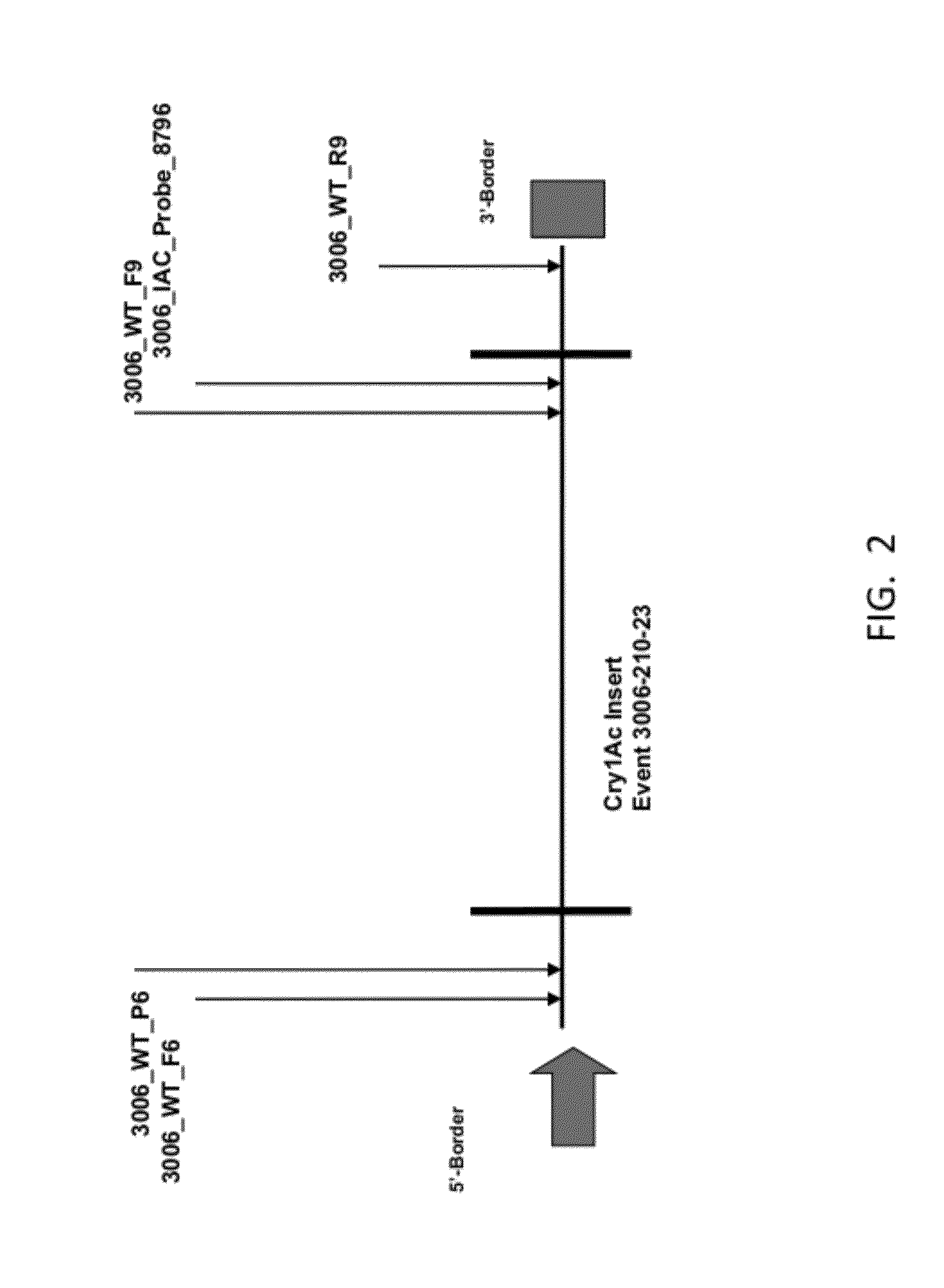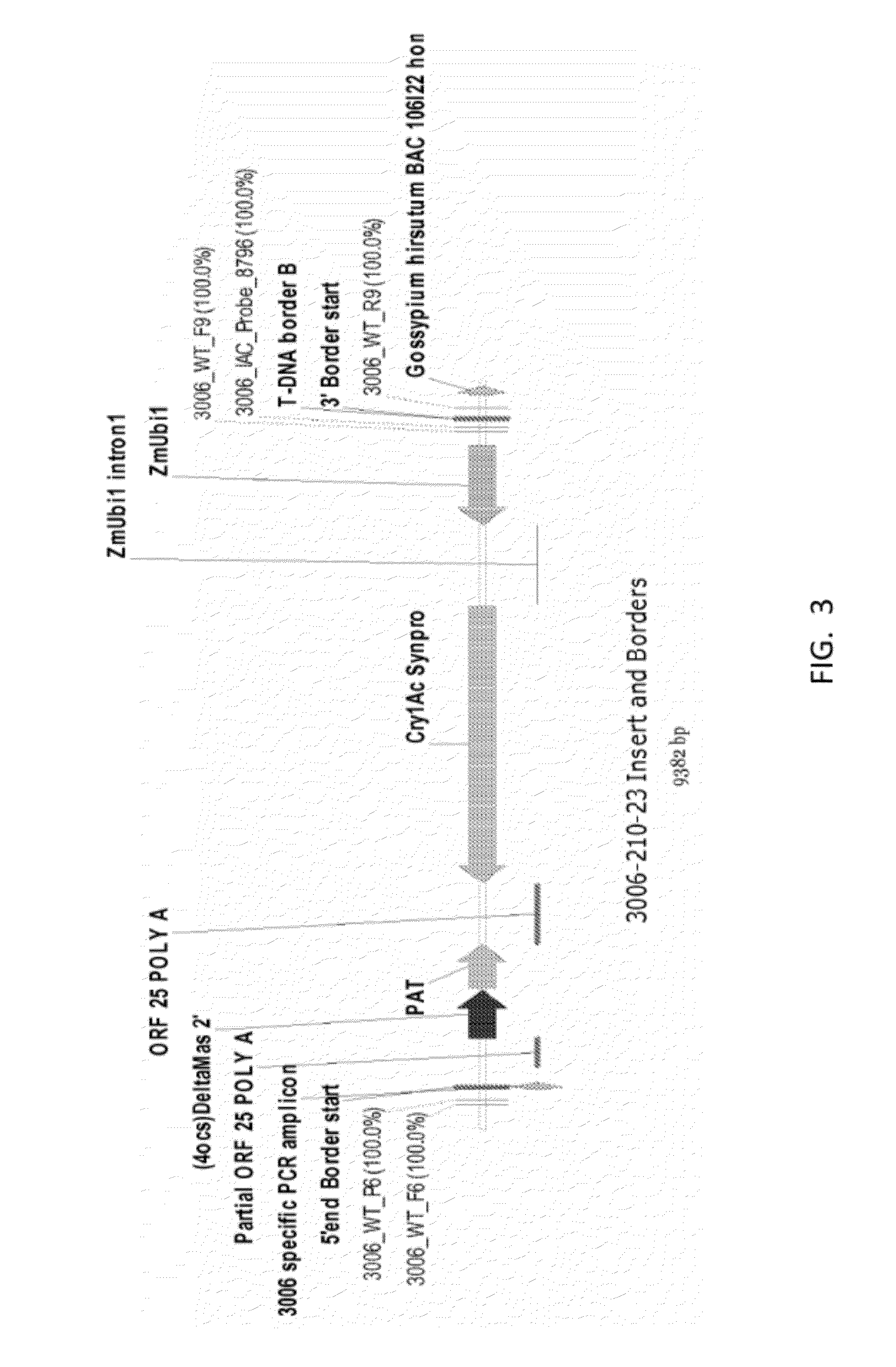ENDPOINT TAQMAN METHODS FOR DETERMINING ZYGOSITY OF COTTON COMPRISING Cry1Ac EVENT 3006-210-23
a technology of cry1ac and taqman, which is applied in the field of endpoint taqman methods for determining zygosity of cotton comprising cry1ac event 300621023, can solve the problems of difficult to differentiate wild-type samples from plant samples that contain transgenes, inconvenient and laborious, and novel kinetics of invader assays, so as to achieve high throughput zygosity analysis, eliminate denaturation step
- Summary
- Abstract
- Description
- Claims
- Application Information
AI Technical Summary
Benefits of technology
Problems solved by technology
Method used
Image
Examples
example 1
Extraction of Genomic DNA
[0088]DNA was extracted from cotton leaf tissue obtained from a single plant using QIAGEN's DNeasy 96 Plant Kit (Qiagen, Valencia, Calif.). The QIAGEN protocol was implemented according to manufacturer's recommendation with a few modifications for the cotton DNA extraction as follows: A final concentration of 10 mM sodium metabisulfite was added during cell lysis and a final concentration of 10 mM DTT was added to the final DNA (Horne et al., 2004). DNA was quantified using PicoGreen® dye from Molecular Probes, Inc. (Eugene, Oreg.). Each well of a microtiter plate contained 100 μl of 200-fold picogreen combined with 5 μl of DNA sample or Lambda DNA standards (0, 2.5, 5, and 10 ng / μl). Plates were shaken briefly using standard plate shaker and read using SpectraMax®fluorometer from Molecular Devices (Sunnyvale, Calif.). The DNA sample concentrations were diluted to 12 ng / μl with sterile water.
example 2
Primer Design and Selection
[0089]Primers and probes (a fluorophore at 5′ end and a Black Hole Quencher™ at 3′end) were designed for both the wild type and transgene using Primer Express® software, version 3.0 (Applied Biosystems, Inc., Foster City, Calif.) and Vector NTI® software, (Invitrogen Corp., Carlsbad, Calif.). Forward and reverse primers were paired, PCR was performed and the results were analyzed by gel electrophoresis (2% agarose e-gel). The most promising candidates were then paired with probes and run on real time PCR. Based on the results from the real time PCR, a transgene primer pair and a wild type primer pair with respective probes were chosen.
example 3
Standard PCR Conditions
[0090]Probes were labeled with different fluorescent dyes (FAM-490 for transgene and Texas Red for wild type). PCR reactions were performed in a final volume of 25 μl containing: 0.2 μM of the common event primer and the transgene forward primer, 0.4 μM of the wild-type forward primer, 0.08 μM of each probe, 0.3 mM of dNTP, 4 mM MgCl2, 2.5 μl of 10% PVP-40, 1 unit of HotStarTaq DNA polymerase (Qiagen, Valencia, Calif.), and 36 ng of template DNA. PVP-40 was added to the reaction to improve PCR fidelity (Horne et al, 2004). PCR reactions were run on GeneAmp® PCR System 9700 Thermocyclers (Applied Biosystems, Inc., Foster City, Calif.) using the following cycling conditions: Individual wild type and transgene PCR reactions denatured at 95° C. for 15 min; 40 cycles of 95° C. for 30 sec, 60° C. for 30 sec. 72° C. for 30 sec, followed by a final extension at 72.0° C. for 5 min. Combined PCR reaction—95° C. for 15 min; 35 cycles of 95° C. for 15 sec, 60° C. for 1 mi...
PUM
| Property | Measurement | Unit |
|---|---|---|
| concentration | aaaaa | aaaaa |
| temperatures | aaaaa | aaaaa |
| temperature | aaaaa | aaaaa |
Abstract
Description
Claims
Application Information
 Login to View More
Login to View More - R&D
- Intellectual Property
- Life Sciences
- Materials
- Tech Scout
- Unparalleled Data Quality
- Higher Quality Content
- 60% Fewer Hallucinations
Browse by: Latest US Patents, China's latest patents, Technical Efficacy Thesaurus, Application Domain, Technology Topic, Popular Technical Reports.
© 2025 PatSnap. All rights reserved.Legal|Privacy policy|Modern Slavery Act Transparency Statement|Sitemap|About US| Contact US: help@patsnap.com



